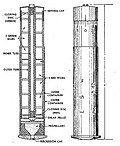| Leuchtpistole 42 | |
|---|---|
 Leuchtpistole 42. | |
| Type | Flare gun |
| Place of origin | Germany |
| Service history | |
| In service | 1943-1945 |
| Used by | Germany |
| Production history | |
| Designer | HASAG |
| Manufacturer | HASAG Metallwarenfabrik C.u.W. Meinel-Scholer Waffenfabrik Moritz & Gerstenberger |
| Specifications | |
| Mass | 1.120 kg (2 lb 7.5 oz) |
| Length | 155 mm (6.1 in) [1] |
| Cartridge | Flare Smoke Panzerwurfkörper 42 Wurfgranate Patrone 326 Wurfkorper 361 |
| Caliber | 26.6 mm (1.05 in) |
| Action | Break action |
| Feed system | Single shot [1] |
The Leuchtpistole 42 or flare gun in English was introduced into German service in 1943 and served throughout World War II.




